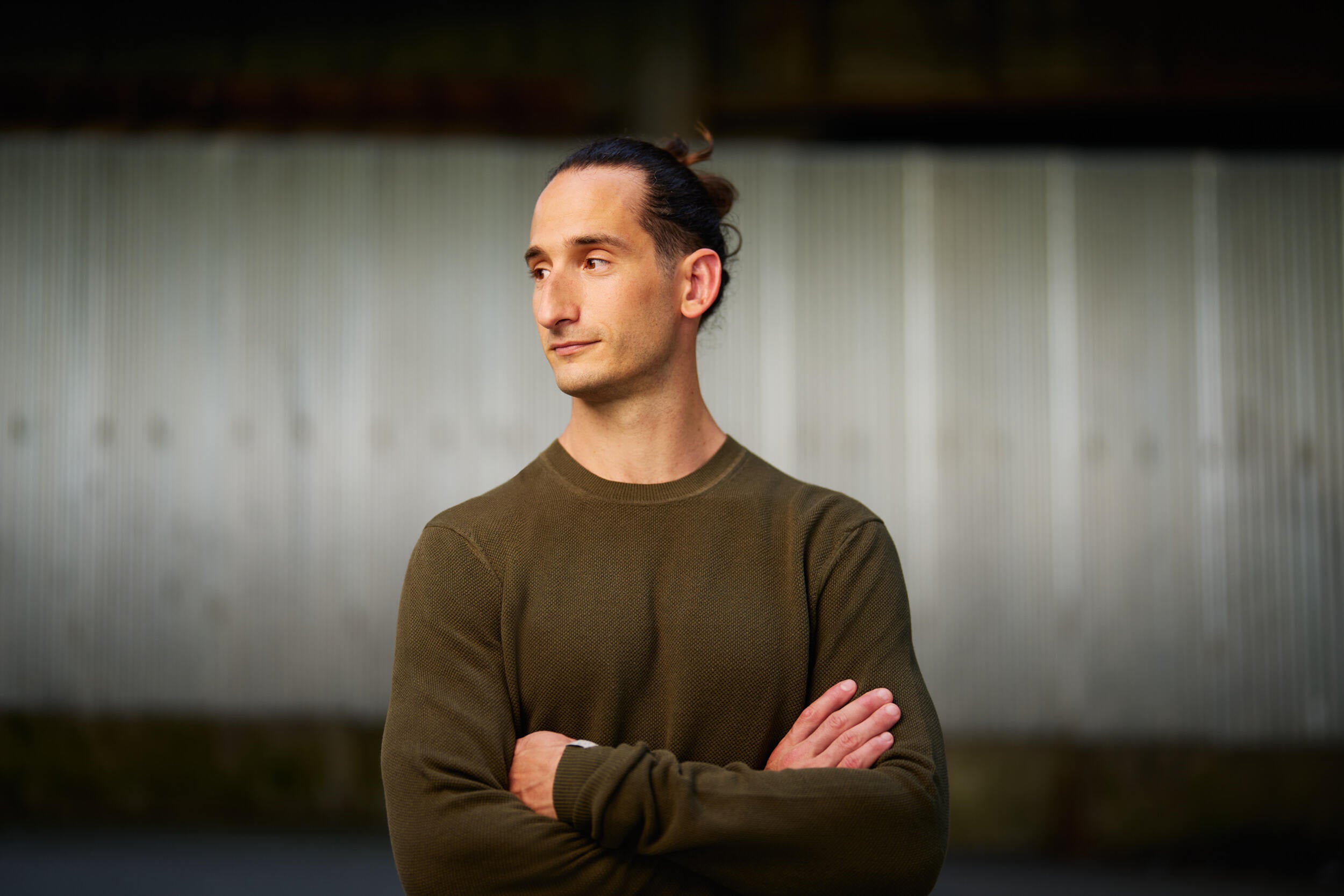TRAINED FOR THE GAMES: This Airman Took on the Titans of Fitness

TRAINED FOR THE GAMES is a four-part interview series that explores the training, nutrition, and recovery of four elite-level athletes that participated in Spartan Games 2.0, presented by U.S. Air Force Special Warfare. Episode 1 will premiere on March 24 at 8 p.m. ET. You can watch on Outside TV, SpartanTV, and Spartan's YouTube channel.
Master Sergeant Layne Mayerstein has been an Explosive Ordnance Disposal Technician in the U.S. Air Force for over 20 years. Put simply, he’s been highly trained to detect, disarm, and dispose of explosive threats, and to do so in some of the most dangerous hot spots in the world. He was in Iraq in 2004, 2007, and 2008, as well as Afghanistan in 2006, 2007, and 2009.
Here at home, Layne is an Air Force Special Warfare Recruiting Squadron Scout Team Sergeant that helps develop prospects to enter into special warfare and combat support careers. But even off duty, the work doesn’t stop. He trains just as hard and with just as much intensity as he does to get combat-ready. He even competes in several events throughout the year.
Related: How to Build an At-Home Gym Like These 4 Elite Spartan Games Athletes
Making an appearance at Spartan Games 2.0, Layne put his combat readiness into action as he went head-to-head with some of the world’s fittest and toughest athletes. (And, he put on quite an impressive performance.)
Here, Layne tells us about what inspired his career choice, his experience in Spartan Games, and how his training has changed over the years.
A Q&A With Spartan Games 2.0 Athlete and MSgt Layne Mayerstein

SPARTAN: What inspired you to join the Air Force?
LAYNE MAYERSTEIN: My dad was in the U.S. Air Force. He was a radar navigator on a B-52. I say he dropped the bombs and I picked them up, but it wasn't as simple as that. When I was a kid, we were exposed to Operation Desert Shield, Desert Storm, and the killing fields, and there were people that we knew from both the Army and Air Force that were involved in events that occurred out there. Initially, when I thought about it, I wanted to be a PJ, or a pararescueman. So, in high school, I started to get in the pool and work and train to be a PJ. My recruiter ended up offering me EOD, and I had no clue what it was. Then I found out that EOD stood for Explosive Ordnance Disposal.
My dad took me over to the EOD shop on Kirtland Air Force Base where I got to meet a few guys, including a guy that really opened my eyes to what EOD was. I decided that it was for me more so than being a PJ. Of course, I was a child during Desert Shield and Desert Storm, but if I'd have been able to take care of that stuff, then those individuals we know would still be living.
SPARTAN: How would you describe your training?
LM: Over the years, I've morphed as I realized that I needed to change. I played football, I wrestled a little bit, and I did some MMA, but my most competitive sport when I was in high school was track — I was a sprinter. Then I started to body build, and at one point I was over 200 pounds. I actually had a bit of a wake-up call when I was in Iraq. I was walking around and I was huffing and puffing as I was moving around on the ground and I just thought, "Man, I'm just not in the shape I need to be in." It was literally the worst thing I could do to my teammates by becoming a risk or a liability to them. So, I started doing more functional work and modifying my programming back toward being an endurance athlete, but the middle distance is where I thrive.
Related: TRAINED FOR THE GAMES: How This Elite CrossFitter Evolves as an Athlete
I was never elite at those distances, but it's great for my weight, structure, and ability level. I was running 5Ks in 17 minutes, doing 10Ks in close to 40 minutes, along with being somewhere around 170 to 180 pounds. Not too big, not too small. Strong enough, but not too big. And I was able to do things that I needed to do. The tour in 2009 was pretty rough, but thank goodness that I was doing all of that functional fitness to get to that point where I was super capable.
SPARTAN: What was the Spartan Games experience like for you?
LM: I showed up and I had a bit of that imposter syndrome. I'm way into CrossFit and have been doing the Open since 2016, with the exception of this year due to a recovery from surgery. I watched Christian Harris and Meg Reardon compete in CrossFit, and seeing them in person made me fanboy a bit. But meeting them, and seeing them get into some of these workouts and just smash themselves, it intimidated the heck out of me.

SPARTAN: What did you think of the Titan Fitness Husacross?
LM: I love that thing. I dropped it on my foot, but I didn't want to let anybody know that I actually dropped it on my foot, so I tried not to react at all, and I just looked around. I was like, "Man, this better not suck." And then I picked it back up and kept going. But yeah, for the rest of the camp, I had a nice bruise on my foot.
Related: TRAINED FOR THE GAMES: This Elite CrossFitter Designs EPIC Programs
SPARTAN: Any advice for carrying it?
LM: I'm so small, so figuring out my placement is huge. Then, it's about adjusting it so that it stays tighter to my body. If I look back on how I actually held it during the first event, I tried to put it between my legs, which is why I lost it and it ended up dropping on my foot. I would've placed it in the crook of my hip and then I would've attempted to sit back a little bit more and then do the knees over toes squat a bit better. That vertical positioning would've been a lot better for me, just because when it pulled me forward, it put everything on my hands and my hands were already toasted. So they were not going to hold on.

SPARTAN: What’s your nutrition like?
LM: I've started to get a bit more into timing and quality versus macros. I was hitting macros pretty heavy beforehand, but I realized that it wasn't helping my body with what I actually needed to perform. The only real macro number that I try to hit is my carbohydrates: I try to get 425 grams of carbs minimum, on a daily basis. And then I increase it, depending on what my cardio output is going to be.
Related: TRAINED FOR THE GAMES: This 'Scrawny Runner' Is Now an Elite Athlete
A typical day is six to eight vegetable servings, and then fruit. I'll eat almonds, bananas, and peanut or almond butter at the end of the day as a snack. This helps get my sleep and recovery going.
I started doing some fasted cardio. Immediately after the fasted cardio, I'd throw down some protein, either eggs or meat or something like that. We get beef directly from a farm now, versus a store. It’s higher quality meat that doesn’t just taste better to me, but I know that I'm also getting better stuff from it. It’s 100% grass-fed, and I've noticed that since I started doing that, I started feeling better.
SPARTAN: What does your recovery protocol look like?
LM: I just got a WHOOP, and today is day five of using it. I like it because it’s a scientific method of being able to track a lot of different metrics. For me, my sleep has not been great. I also have Normatec boots, a Hyperice X, and a scraping tool. I use pretty much everything I can to mobilize muscle and flush fluids. If I could get into a red bed and do cryo on a regular basis, I would do that as well. Preemptively, I also do rehab to maintain stability and mobility or range of motion, take beet supplements so that I'm able to take in some of the benefits of being able to transport more oxygen, and do deep breathing training with an Airofit breathing trainer.
SPARTAN: What's one of your go-to Spartan workouts?
LM: With a 20-pound vest, do 100 burpees, run 5 miles, and then do another 100 burpees.
Train Like Layne Mayerstein for a Week

Layne describes his training as a hybrid program that incorporates a lot of different endurance distances to simulate Spartan races and DEKA events. A lot of his programming is also CrossFit-inspired. His training schedule technically begins on a Tuesday, with Mondays being focused on active recovery or rest.
Monday:
Rest/mobility/recovery: a 1-hour yoga session, walk, or massage
Tuesday:
AM: Long, slow distance: 8-14 miles @ Zone 2 on foot (manual curve runner/road/trail)
PM: Skill work, breath-based pacing with gymnastics, snatches, machines (air bike/runner/ski/rower)
Wednesday:
AM: 30-90-minute recovery cardio (machine)
PM: Squats, short-to-moderate metcons, knee/shoulder/hip prehab
Thursday:
AM: Intervals (sprints on foot or machine with a heart rate-, pace-based effort.
His favorite is 4-6 blocks of:
Row 6 x 30/30
— 30 seconds @ 1:40/500 meters
— 30 seconds @ 2:20/500 meters
PM: Barbell capacity work: DEKA-style metcon with extra emphasis on machines
Friday:
Rest/mobility/recovery: a 1-hour yoga session, walk, or massage
Saturday:
AM/PM:
Challenges/race simulation with hydration and fueling strategies (for longer domains such as a Beast). Training will be on foot or a machine, or something to mimic anything obstacle-related (Spartan or DEKA). More emphasis is on cardio, which typically means a run, plus machine or multi-machine work.
Sunday:
AM/PM:
More challenges/race simulation with hydration/fueling strategies (for shorter domains such as a Super or Sprint). Training will once again be on foot or a machine, with more emphasis on obstacle completion at a higher heart rate.
U.S. Air Force Special Warfare takes mental and physical toughness to the next level, which is why they were the perfect partner for this year’s Spartan Games. To learn more about the heroes who make up the top 1% of the 1%, click here.


